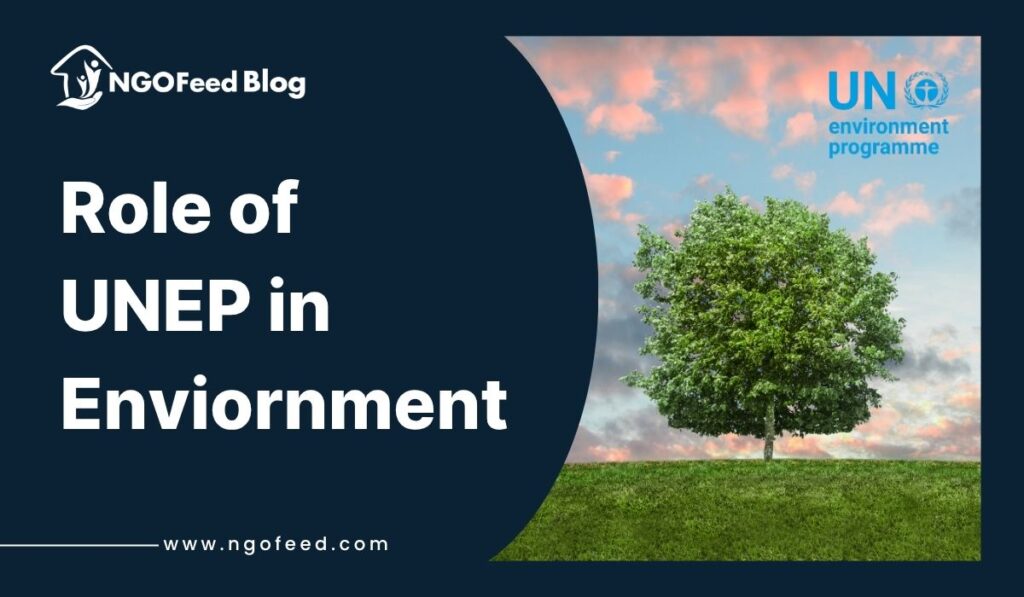Role of UNEP in Environment: Created in 1972 after the historic Stockholm Conference on the Human Environment, UNEP has become the voice for the environment inside the UN structure. Inspiring, educating, and empowering countries and people to raise their quality of life without endangering future generations is its goal.
From the climate catastrophe to ecosystem deterioration, we confront hitherto unheard-of environmental problems in 2025; thus, UNEP’s leadership in advancing sustainable development, policy frameworks, and multilateral environmental cooperation is more crucial than ever.
Also Read: Role of NGOs in Sustainable Agriculture
Table of Contents
Role of UNEP in Environment Core Goals and Requirements
Among UNEP’s wide scope include:
- watching the shape of the world ecology
- Helping to negotiate global environmental accords
- Helping nations to put environmental regulations into effect
- Increasing knowledge and developing capabilities
- Promoting sustainable consumption and manufacturing behaviors
Essential Emphasis of UNEP’s Worldwide Leadership
A. Adaptations for Climate Change Reduction
UNEP is instrumental in:
- Supporting climate-resilient infrastructure in poor nations
- Publishing authoritative reports like the Emissions Gap Report
- Promoting environmentally friendly solutions and clean energy transitions
- Holding coalitions like the Climate and Clean Air Coalition (CCAC)
Also Read: Role of UNHRC in India
B. Biodiversity and Natural Conservation
UNEP pushes:
- sustainable management of marine, freshwater, and terrestrial ecosystems
- Restoration of damaged terrain via the UN Decade on Ecosystem Restoration (2021–2030)
C. Pollution Management
UNEP tackles pollution using:
- The Global Chemicals Outlook
- Measures against plastic and marine litter (e.g., Clean Seas Campaign)
- Frameworks like the Stockholm, Basel, and Minamata Conventions
D. Green and Circular Economies
UNEP supports:
- Sustainable financing by the UNEP Finance Initiative (UNEP FI)
- Programmes for green recovery following COVID-19 and for climate resilience
UNEP’s Part in Environmental Crises
Leading in post-crisis environmental evaluations and restoration efforts as well: UNEP
- Natural catastrophes—earthquakes, floods, tsunamis
- Industrial disasters (toxic chemical releases, oil spills)
- Armed conflicts impacting bodies of water and ecosystems
- Example: UNEP’s research in Ukraine (2022–2024) to assess war-related ecological destruction including chemical spills, air and water pollution, and soil contamination.
Research and Educational Contributions of UNEP
- Advances Environmental Education for Sustainable Development (EESD).
- Collaborators under the Global Universities Partnership on Environment for Sustainability (GUPES) with universities
- Through the TUNZA Programme, helps young projects.
- Distributes open-access resources through InforMEA and UNEP Live.
Role of UNEP in Environment Partnerships and Collaborations
Close collaboration of UNEP with:
Also Read: Role of NGOs in Sustainable Development
- Other United Nations entities—UNDP, FAO, WHO, UNESCO, WMO
- – Academic institutions and international NGOs.
- Regional organizations such the African Ministerial Conference on the Environment (AMCEN)
- Financial institutions and corporate partners through ESG projects and green financing
UNEP collaborates with secretariats of multilateral environmental agreements (MEAs) as well as:
- Convention on Biological Diversity (CBD)
- Convention on Migratory Species
- Convention on International Trade in Endangered Species (CITES)
Local and National Programs
Operating regional offices across Asia-Pacific, Africa, Latin America and the Caribbean, West Asia, Europe, and North America, UNEP’s regional concentration is:
- Battling desertification in Africa
- Amazon Basin’s Forest Conservation
- Cutting down on plastic waste in Southeast Asia
- Preservation of the marine ecology in the Arctic and Mediterranean
- In addition, UNEP helps nations to create Green Growth Strategies, Nationally Determined Contributions (NDCs), and National Environmental Action Plans (NEAPs).
Key UNEP-driven worldwide initiatives
- The main worldwide vehicle for environmental education, World Environment Day, is observed on June 5.
- Beat Plastic Pollution
- Faith for Earth Project
- Action Now for Nature Campaign
- Against wildlife trafficking, wild for life campaign
- These initiatives unite stakeholders in common environmental activity and touch millions all around.
Also Read: Role of NGOs in Biotechnology
UNEP’s Vision for 2025:
Triple planetary catastrophe UNEP is concentrating on in 2025:
- Pollution and garbage
- Nature’s loss of biodiversity
Among UNEP’s forward-looking vision are:
- Strengthening climate resilience in the least developed nations (LDCs)
- Incorporating sustainability into international finance and trade
- Encouraging digital invention in environmental monitoring (AI, satellite data)
- Post-2020 Biodiversity Targets: improving international collaboration
- Guided by inclusion, innovation, and scientific integrity, UNEP’s Medium-Term Strategy (2022–2025) specifies ambitious goals in the domains of nature, climate, and pollution.
Solutions Based on Challenges – FAQ
Political opposition to environmental rules
Increasing local participation and country ownership
Inconsistent access to green technologies
Improving honesty and accountability
Conclusion
Navigating the difficult landscape of ecological deterioration, climate injustice, and economic inequality, the United Nations Environment Programme (UNEP) has set itself as a worldwide steward of environmental sustainability. Beyond policy, it shapes attitudes, empowers villages, and promotes a sense of worldwide ecological solidarity.
UNEP’s direction becomes more important now than ever in 2025 as the planet approaches a crucial environmental crossroads. The need to act is not abstract; it is grounded in the growing intensity of wildfires, floods, zoonotic diseases, and ecosystem collapses. UNEP leads with scientific credibility, policy creativity, and a vision rooted in equity and intergenerational justice.
Also Read: Role of NGOs in Sustainable Development
Supporting UNEP is an investment in a shared future—one where informed, engaged citizens protect not only institutions but also the earth, where development and nature coexist, and resilience is ingrained in every community.



